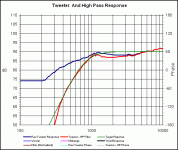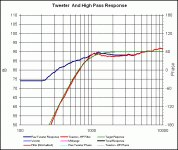Thanks for that, pano 
I should find a sim (or formula) to see if 1st order at 1500 ~= 4th order at 800
Cheers

I should find a sim (or formula) to see if 1st order at 1500 ~= 4th order at 800
Cheers
otto88 said:if 1st order at 1500 ~= 4th order at 800
It won't be the same. Different slope, very different phase behavior.
First. A graph with a 4th order high pass. The green line is the target - Linkwitz-Reilly 4th order roll off. Had to play with cap and inductor values a little to get a good match.
Attachments
panomaniac said:Here's the response, phase and filter plot.
You can see that the 1st order filter gives a long slope.
To clarify, that's actually an acoustic 2nd order slope. If you want to achieve an acoustic 1st order rolloff with a single cap, you need a flat raw driver response far down to lower frequencies. In fact, there are few high-frequency drivers that can be used for acoustic 1st order.
a 2" dome midrange that will do it
In case anyone else is looking, I found a 2" dome midrange that will do it:
http://www.parts-express.com/pe/sho...TR=Dayton RS52&CFID=14659692&CFTOKEN=53424665
91 dB
Tests well:
From http://www.zaphaudio.com/smalltest/
"Excellent performing with a very wide, smooth bandwidth and low distortion. Can be crossed over relatively high, though the breakup will need some attention. Low end distortion is clean, so the lower crossover point depends only on how loud the driver will be played.
I estimate LR4 500 Hz, or LR2 800 Hz.
A conjugate LCR trap will likely have to be used to flatten this driver's impedance. This driver has a well designed motor with faraday"
Alsoe does well here:
http://www.audioheuristics.org/measurements/Testing/Midrange2/midrange_2_test_data.htm
In case anyone else is looking, I found a 2" dome midrange that will do it:
http://www.parts-express.com/pe/sho...TR=Dayton RS52&CFID=14659692&CFTOKEN=53424665
91 dB
Tests well:
From http://www.zaphaudio.com/smalltest/
"Excellent performing with a very wide, smooth bandwidth and low distortion. Can be crossed over relatively high, though the breakup will need some attention. Low end distortion is clean, so the lower crossover point depends only on how loud the driver will be played.
I estimate LR4 500 Hz, or LR2 800 Hz.
A conjugate LCR trap will likely have to be used to flatten this driver's impedance. This driver has a well designed motor with faraday"
Alsoe does well here:
http://www.audioheuristics.org/measurements/Testing/Midrange2/midrange_2_test_data.htm
- Status
- Not open for further replies.


